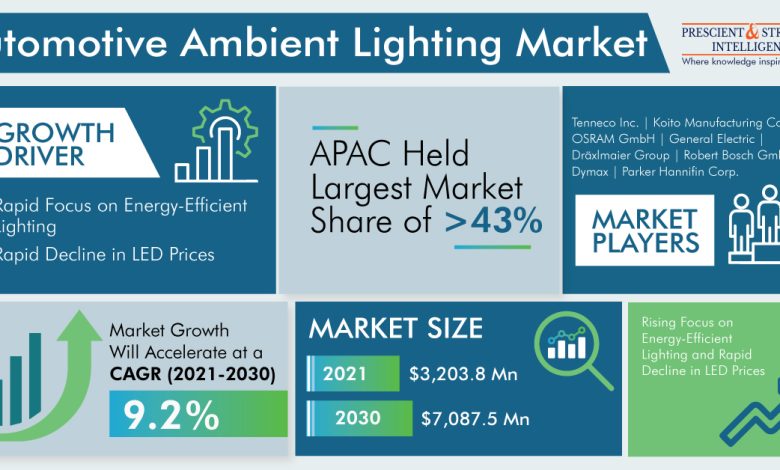Automotive Ambient Lighting Market To Reach about $7,088 Million by 2030
Automotive Ambient Lighting Market Growth Analysis

Automotive Ambient Lighting Market
The sale of automotive ambient lighting is expected to reach $7,087.5 million value by 2030. The rising demand for budget cars, which are the biggest consumers of roof console lights, reading lights, and car body lights, is a major factor driving the demand for automotive ambient lighting.
In order to make the inside of the car feel livelier, the automotive ambient lighting directs the flashing of the lights. Additionally, it includes the regions close to the door handles and footwells. It provides lighting based on the driver’s mood, the vehicle’s safety and security, and the car’s interior design.
Additionally, it provides reading lighting and aids in lowering driver tiredness. It is frequently used in high-end automobiles.
Consumers’ entire way of life has changed as the state of the world economy has improved. The appetite for new, inexpensive technology is expanding as a result of rising disposable money and changing lifestyles. This positively impacts global sales of ultra-luxury cars. A shift in lifestyle may be observed in developing countries like China and India.
The rising desire for consumer-preferred cabin comfort and a sense of design in North America is the primary cause of the region’s growing personalization. In order to make the interiors of their cars more appealing and atheistic, people are more drawn to automobile ambient interior lighting.
Continuous Efforts to Improve Indoor Lighting
At first, the practical applications of interior lighting in automobiles were given precedence, such as improved sight and orientation. Mood, wellness, and character are all taken into account as the need for indoor lighting increases. This is attributed to the growing need for customized lighting that adapts to people’s tastes.
Additionally, a greater accumulation of practical and emotional aspects in automobiles is anticipated in the future. With the main goal of generating added value in the lighting segment via emotional, practical, and aesthetic factors, virtually no area of the car’s inside will be disregarded.
For instance, luxury manufacturers like Lexus, Mercedes-Benz, and BMW provide attractive and brilliant ambient lighting choices for modern vehicles. A lot of high-end car models, including Bentley and Rolls-Royce, use ambient lighting.
They enhance grandeur by creating breathtaking visual effects with ambient lighting. For instance, Rolls-Royce transforms the headliner into the night sky using fiber-optic strands inserted into the headliner. Likewise, Bentleys’ high-end sound systems’ door speakers are illuminated to highlight certain characteristics.
Favorable Trends
Customer customization is becoming more popular, helping to drive demand. The need for ambient interior lighting is expanding in tandem with the rise in automobile customization requirements in terms of design, functionality, and convenience.
Aftermarket lighting modifications are one of the quickest, least expensive methods to alter the look and feel of a vehicle. The most popular lighting solutions for improving a car’s interior are LED light strips and wheel illumination, among others.
As a result, there is an increasing need for automotive ambient lighting. The need for automobile interior ambient lighting is also changing significantly, particularly in emerging and developed nations, thanks to new breakthroughs like OLEDs and LEDs.
Automotive Ambient Lighting Market
The sale of automotive ambient lighting is expected to reach $7,087.5 million value by 2030. The rising demand for budget cars, which are the biggest consumers of roof console lights, reading lights, and car body lights, is a major factor driving the demand for automotive ambient lighting.
In order to make the inside of the car feel livelier, the automotive ambient lighting directs the flashing of the lights. Additionally, it includes the regions close to the door handles and footwells. It provides lighting based on the driver’s mood, the vehicle’s safety and security, and the car’s interior design.
Additionally, it provides reading lighting and aids in lowering driver tiredness. It is frequently used in high-end automobiles.
Consumers’ entire way of life has changed as the state of the world economy has improved. The appetite for new, inexpensive technology is expanding as a result of rising disposable money and changing lifestyles. This positively impacts global sales of ultra-luxury cars. A shift in lifestyle may be observed in developing countries like China and India.
The rising desire for consumer-preferred cabin comfort and a sense of design in North America is the primary cause of the region’s growing personalization. In order to make the interiors of their cars more appealing and atheistic, people are more drawn to automobile ambient interior lighting.
Continuous Efforts to Improve Indoor Lighting
At first, the practical applications of interior lighting in automobiles were given precedence, such as improved sight and orientation. Mood, wellness, and character are all taken into account as the need for indoor lighting increases. This is attributed to the growing need for customized lighting that adapts to people’s tastes.
Additionally, a greater accumulation of practical and emotional aspects in automobiles is anticipated in the future. With the main goal of generating added value in the lighting segment via emotional, practical, and aesthetic factors, virtually no area of the car’s inside will be disregarded.
For instance, luxury manufacturers like Lexus, Mercedes-Benz, and BMW provide attractive and brilliant ambient lighting choices for modern vehicles. A lot of high-end car models, including Bentley and Rolls-Royce, use ambient lighting.
They enhance grandeur by creating breathtaking visual effects with ambient lighting. For instance, Rolls-Royce transforms the headliner into the night sky using fiber-optic strands inserted into the headliner. Likewise, Bentleys’ high-end sound systems’ door speakers are illuminated to highlight certain characteristics.
Favorable Trends
Customer customization is becoming more popular, helping to drive demand. The need for ambient interior lighting is expanding in tandem with the rise in automobile customization requirements in terms of design, functionality, and convenience.
Aftermarket lighting modifications are one of the quickest, least expensive methods to alter the look and feel of a vehicle. The most popular lighting solutions for improving a car’s interior are LED light strips and wheel illumination, among others.
As a result, there is an increasing need for automotive ambient lighting. The need for automobile interior ambient lighting is also changing significantly, particularly in emerging and developed nations, thanks to new breakthroughs li OLEDs and LEDs.




